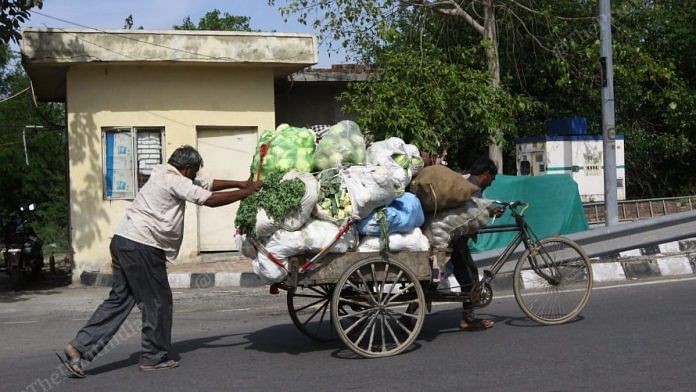On front pages Friday, it’s all about Prime Minister Narendra Modi’s video conference Thursday with states on a slow but gradual lifting of the Covid-19 lockdown, curbing a second wave of infection and how the Tablighi Jamaat last month is largely responsible for the upsurge of infections in the country.
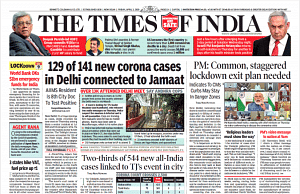 The lead story in The Times of India ‘129 of 141 new corona cases in Delhi connected to Jamaat’, clearly puts the blame on the Tablighi Jamaat for the upsurge in coronavirus cases. The daily reports, “In a huge upsurge in cases, Delhi recorded 141 new ones on Thursday, among them a senior resident at AIIMS and his pregnant wife. He is now the eighth doctor to test positive. The Tablighi Jamaat evacuees accounted for 129 of the fresh cases.”
The lead story in The Times of India ‘129 of 141 new corona cases in Delhi connected to Jamaat’, clearly puts the blame on the Tablighi Jamaat for the upsurge in coronavirus cases. The daily reports, “In a huge upsurge in cases, Delhi recorded 141 new ones on Thursday, among them a senior resident at AIIMS and his pregnant wife. He is now the eighth doctor to test positive. The Tablighi Jamaat evacuees accounted for 129 of the fresh cases.”
In a rather telling paragraph, the daily states, “A disturbing aspect has been the unruly behaviour of these evacuees at all the hospitals which is posing a serious challenge to the medical staff and has compelled state health secretary Padmini Singla to write to the Delhi police commissioner for adequate deployment.”
In other news about the Tablighi Jamaat, ‘Two-thirds of 544 new all-India cases linked to TJ’s event in city’, the paper says “…at least 347 delegates at the religious congregation at Nizamuddin in Delhi last month tested positive for Covid-19, accounting for 65% of the new 544 confirmed nationwide cases (at the time of going to press).”
The other important story of the day is the post-lockdown plan proposed by the PM. In `Common staggered exit plan…’’, the paper says, “Indicating that there is need for a coordinated approach to lifting of restrictions after the national lockdown ends on April 14 to ensure that the gains of social distancing and isolation… are not lost, Prime Minister Narendra Modi on Thursday asked chief ministers to consider a common exit strategy once the lockdown ends.”
And for news about the media, something that concerns TOI a great deal, there is an article on, “Blocking newspaper delivery a legal offence: Top lawyers”.
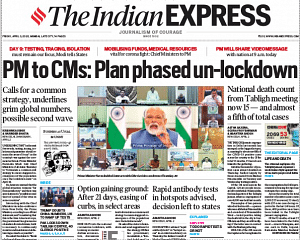 For the second successive day, The Indian Express goes with an overarching headline, eight columns today. Express’ lead is Modi’s interaction with chief ministers to plan a phased un-lockdown. The paper says he called for a common strategy, underscored that the global numbers regarding the virus were still grim and there could be a possible second wave.
For the second successive day, The Indian Express goes with an overarching headline, eight columns today. Express’ lead is Modi’s interaction with chief ministers to plan a phased un-lockdown. The paper says he called for a common strategy, underscored that the global numbers regarding the virus were still grim and there could be a possible second wave.
Like TOI, Express baldly blames the Tablighi Jamaat for the sudden spurt in cases: “National death count from Tabligh meeting now 15 — and almost a fifth of total cases”. It reports, “The Tablighi Jamaat congregation… has emerged as the biggest hotspot, accounting for about one-fifth of the COVID-19 positive cases across the country so far.’’
Express highlights how the Delhi Tablighi Jamaat episode could have been better handled with the example of Maharashtra: In its report, ‘After first two cases, Maharashtra cancelled go-ahead for Tabligh meet timed with Delhi’, it writes, “Around the same time members of the Tablighi Jamaat gathered at the Nizamuddin dargah in Delhi, a congregation was scheduled in Vasai, 50 km from Mumbai. The Maharashtra government, however, cancelled permission for the event, preventing what could have become a Delhi-like Covid-19 hotspot.’’ The organisers had received permission for the same earlier in the year. “However, on March 6, four days after Maharashtra registered its first two Covid-19 cases, the state government realised it would be wise to cancel the event.”
And a report on the weakening economic situation in the country over the last year, says that, ‘As growth slows, demand for work under MNREGA shoots to 9-yr high’. In rather telling statistics, the report explains, “… the demand for work by households under the MGNREGA programme surged to a nine-year high in 2019-20. According to figures uploaded on the MGNREGA official portal, 5.47 crore households sought MGNREGA works, the highest since 2010-11, when the number was 5.5 crore. It was 5.27 crore in 2018-19.”
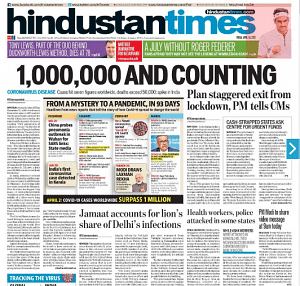 Hindustan Times’ lead story is in all caps, perhaps to put the message across forcefully: ‘1,000,000 AND COUNTING’, as the paper dramatically describes how Covid-19 went from a mystery to a pandemic in 93 days.
Hindustan Times’ lead story is in all caps, perhaps to put the message across forcefully: ‘1,000,000 AND COUNTING’, as the paper dramatically describes how Covid-19 went from a mystery to a pandemic in 93 days.
“At exactly 12pm IST on December 31, a 280-word report from news agency AFP made its way to newsrooms around the world.’’ about a “mystery’’ virus was causing “viral pneumonia of unknown origin” in the city of Wuhan, where 27 people had been infected till then. The story drew little attention, as the world prepared to celebrate the beginning of a new year later that night. In less than 100 days – Thursday is the 93rd day to be precise – the virus has infected 1 million people and killed 50,000, ripping through 203 countries…. Till now, a little over 200,000 have recovered from the disease.”
Differing from other newspapers, HT’s headline regarding Tablighi Jamaat is vague and bland: “Jamaat accounts for lion’s share of Delhi’s infections”.
And, in what was Thursday’s big story, HT reports on, ‘Health workers, police attacked in some states’. It says, “Madhya Pradesh police arrested seven people on Thursday for allegedly attacking and hurling stones at two doctors in Indore, the latest in a string of assaults on frontline health workers by local residents across India, complicating the already uphill battle against the coronavirus disease.”
The urgency to provide PPE protection for medical staff is reflected in the report, ‘17 companies asked to help meet 38mn unit PPE shortfall’.
“For 17 firms that have been tasked with making the coveralls — it is a race against time that involves dealing with raw material shortage, workers worried about their safety, and learning to quickly produce under the watchful and anxious eyes of the government.”
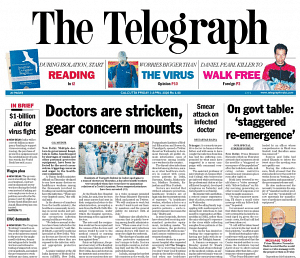 The Kolkata daily’s lead story is ‘Doctors are stricken, gear concern mounts’ — highlighting the plight of medical staff.
The Kolkata daily’s lead story is ‘Doctors are stricken, gear concern mounts’ — highlighting the plight of medical staff.
The paper reports, “Multiple doctors in government hospitals in India, handicapped by shortages of masks and other personal protective equipment, have been infected by the novel coronavirus, triggering concerns and anger in the healthcare community”. A Union health ministry official on Thursday declined to say how many doctors or healthcare workers among the thousands involved in treating coronavirus patients have the infection. “There are very limited cases,” the official said.
However Harjit Bhatti, a geriatric medicine specialist told The Telegraph, “We believe around 50 doctors have been infected so far across the country.”
The paper also reports, ‘On govt table: `staggered re-emergence’’. It states, “Prime Minister Narendra Modi on Thursday advised chief ministers about the need for a ‘staggered reemergence of the population’ after the lockdown ends, indicating certain restrictive measures may remain in place even after April 14….Government sources said that while there were no plans yet to extend the lockdown beyond April 14, given the economic costs, the final call had not been taken yet.”
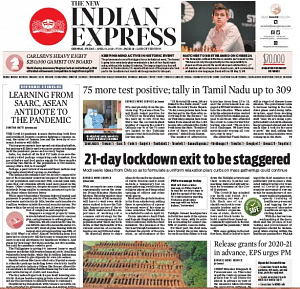 In ‘21-day lockdown exit to be staggered’, The New Indian Express notes that the presence of two “heavyweight ministers”, Amit Shah and Rajnath Singh, at the PM’s video conference with chief ministers “underlined the gravity of the situation, as carelessness at the Tablighi Jamaat headquarters in Delhi has made it the epicentre of the virus, with its activists accounting for almost one-fifth of positive cases in India.”
In ‘21-day lockdown exit to be staggered’, The New Indian Express notes that the presence of two “heavyweight ministers”, Amit Shah and Rajnath Singh, at the PM’s video conference with chief ministers “underlined the gravity of the situation, as carelessness at the Tablighi Jamaat headquarters in Delhi has made it the epicentre of the virus, with its activists accounting for almost one-fifth of positive cases in India.”
In a column-piece ‘Learning from SAARC, ASEAN antidote to the pandemic’, the newspaper conducts a “peer review” of how India’s neighbours have tackled Covid-19 lockdowns. It notes how Vietnam deferred rentals and pensions, Thailand lowered water and electricity bills, Singapore scrapped property taxes etc. “A sneak peak [into what other countries have been doing] indicates that our stimulus efforts need more meat on the bones”, it reports.
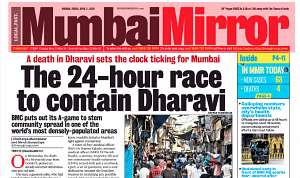 Another alarming headline in Mumbai Mirror says, “A death in Dharavi sets the clock ticking for Mumbai, The 24-hour race to contain Dharavi”. The Mumbai daily reports, “On Wednesday, the death of a 56-year-old man from Covid-19, pushed an already-stretched administration into red alert. The man, a garment seller, who had tested positive earlier in the day was a resident of Dharavi. The slum spread over 2.2 kilometres has a population of about eight lakh and is one of the most densely-populated areas in the world. A community spread in Dharavi, they knew, would be lethal to Mumbai’s fight against coronavirus.”
Another alarming headline in Mumbai Mirror says, “A death in Dharavi sets the clock ticking for Mumbai, The 24-hour race to contain Dharavi”. The Mumbai daily reports, “On Wednesday, the death of a 56-year-old man from Covid-19, pushed an already-stretched administration into red alert. The man, a garment seller, who had tested positive earlier in the day was a resident of Dharavi. The slum spread over 2.2 kilometres has a population of about eight lakh and is one of the most densely-populated areas in the world. A community spread in Dharavi, they knew, would be lethal to Mumbai’s fight against coronavirus.”
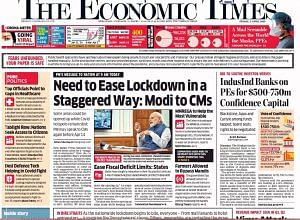 The Economic Times’ lead also covers the PM’s video conference with chief ministers. In another story, “Restaurants, cinemas & retailers at malls seek zero rentals till May”, the paper notes that India’s largest restaurant chains, retailers and multiplexes including McDonalds have “cited zero revenues in the immediate term and a drop of at least 50% in revenues for several months to come. Small businesses in malls have also made similar demands.”
The Economic Times’ lead also covers the PM’s video conference with chief ministers. In another story, “Restaurants, cinemas & retailers at malls seek zero rentals till May”, the paper notes that India’s largest restaurant chains, retailers and multiplexes including McDonalds have “cited zero revenues in the immediate term and a drop of at least 50% in revenues for several months to come. Small businesses in malls have also made similar demands.”
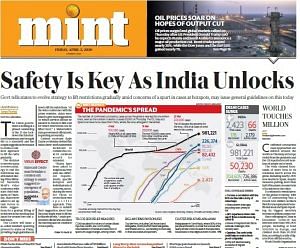 Note how the newspaper always favors big, bold headlines. Mint’s lead today is “Safety is Key As India Unlocks” also covers the Union government’s plans to gradually lift the lockdown. It includes a comment from Maharashtra CM Uddhav Thackeray: “The Prime Minister said that state governments should not lift the lockdown immediately from 15 April but it should happen in phases.”
Note how the newspaper always favors big, bold headlines. Mint’s lead today is “Safety is Key As India Unlocks” also covers the Union government’s plans to gradually lift the lockdown. It includes a comment from Maharashtra CM Uddhav Thackeray: “The Prime Minister said that state governments should not lift the lockdown immediately from 15 April but it should happen in phases.”
In some positive developments on mass testing, the anchor story ‘Govt fast-tracks approval of kits to speed up virus testing’, says that states can now use rapid testing kits. However, India still faces another challenge to mass testing as there are just 178 laboratories in the country that have been approved by ICMR, it notes.
 Like New Indian Express and Mint, Business Standard’s lead uses the word “staggered” to describe the Union government’s post-lockdown strategy (“PM suggests staggered lifting of lockdown”.
Like New Indian Express and Mint, Business Standard’s lead uses the word “staggered” to describe the Union government’s post-lockdown strategy (“PM suggests staggered lifting of lockdown”.
The paper’s anchor story, ‘Cities locked out for Covid-19, struggle in villages of another magnitude’, perhaps tells you why the lockdown has to be lifted in a staggered manner post 15 April. It begins with a tale from Uttar Pradesh potato-plucker Maya Devi, who like many, have “tales of how Covid19 has pushed them to the wall”. The report finds that despite many farm-related activities being exempted from the lockdown, the harvest of potato and wheat in west UP is slow as movement restrictions persist and more and more migrant workers leave for home.


